Employee Resistance to Change: Mazoo Manufacturing Case Study
VerifiedAdded on 2019/12/03
|9
|2669
|180
Case Study
AI Summary
This case study examines employee resistance to change within Mazoo Manufacturing Ltd., a plastic cup manufacturer undergoing significant operational changes. The paper explores the sources of resistance, including poor communication, self-interest, lack of trust, insecurity, and inadequate training, and how these factors manifest in the workplace. It analyzes the impact of resistance on productivity, employee morale, and the overall success of change initiatives. The study then proposes several measures management can take to mitigate resistance, such as improved communication, fostering trust, employee involvement, providing training, and recognizing the need for change. The analysis offers practical strategies for organizations facing similar challenges, emphasizing the importance of proactive change management and employee engagement to ensure successful implementation of new strategies and maintain a positive and productive work environment.

Short Case Study
1
1
Paraphrase This Document
Need a fresh take? Get an instant paraphrase of this document with our AI Paraphraser
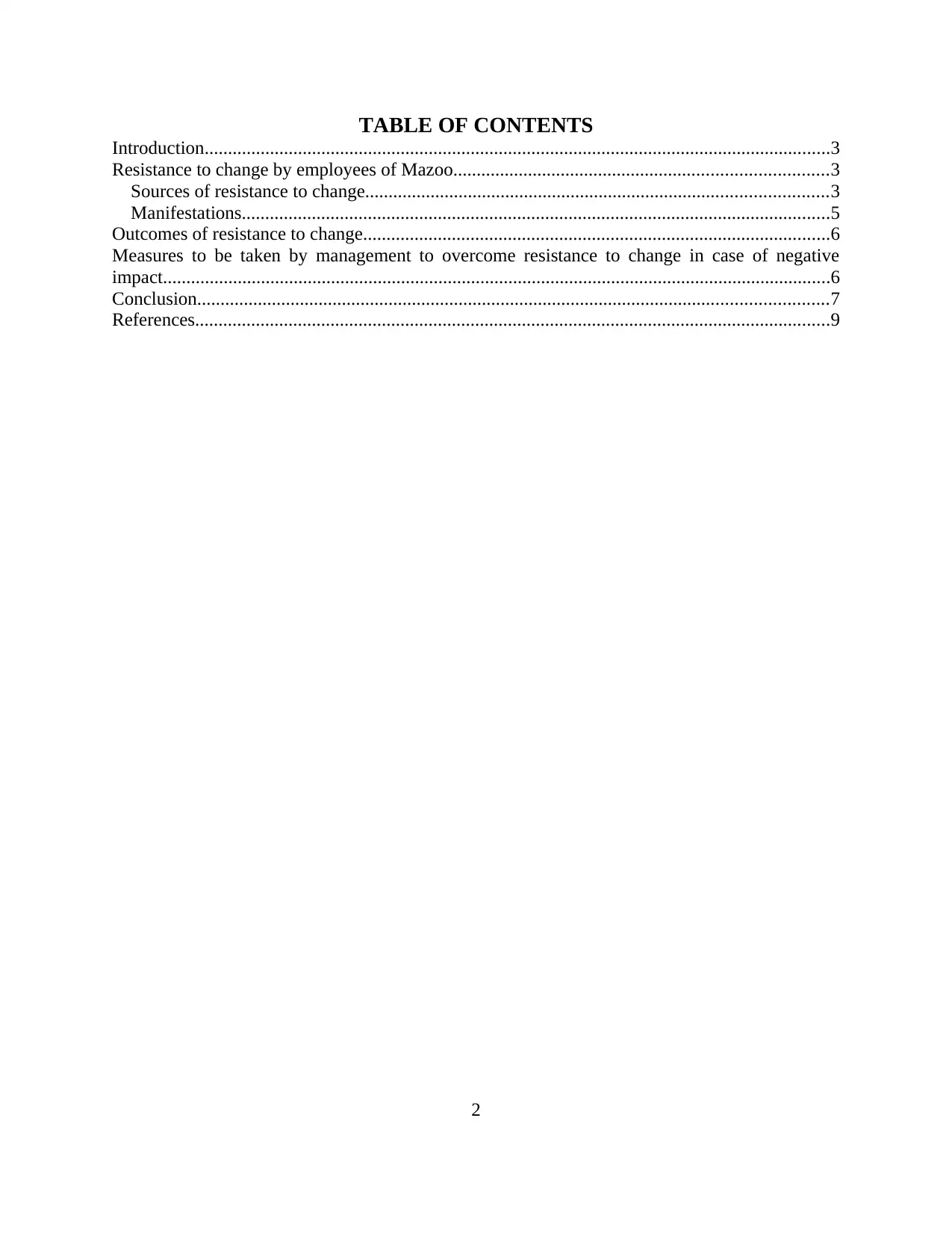
TABLE OF CONTENTS
Introduction......................................................................................................................................3
Resistance to change by employees of Mazoo................................................................................3
Sources of resistance to change...................................................................................................3
Manifestations..............................................................................................................................5
Outcomes of resistance to change....................................................................................................6
Measures to be taken by management to overcome resistance to change in case of negative
impact...............................................................................................................................................6
Conclusion.......................................................................................................................................7
References........................................................................................................................................9
2
Introduction......................................................................................................................................3
Resistance to change by employees of Mazoo................................................................................3
Sources of resistance to change...................................................................................................3
Manifestations..............................................................................................................................5
Outcomes of resistance to change....................................................................................................6
Measures to be taken by management to overcome resistance to change in case of negative
impact...............................................................................................................................................6
Conclusion.......................................................................................................................................7
References........................................................................................................................................9
2
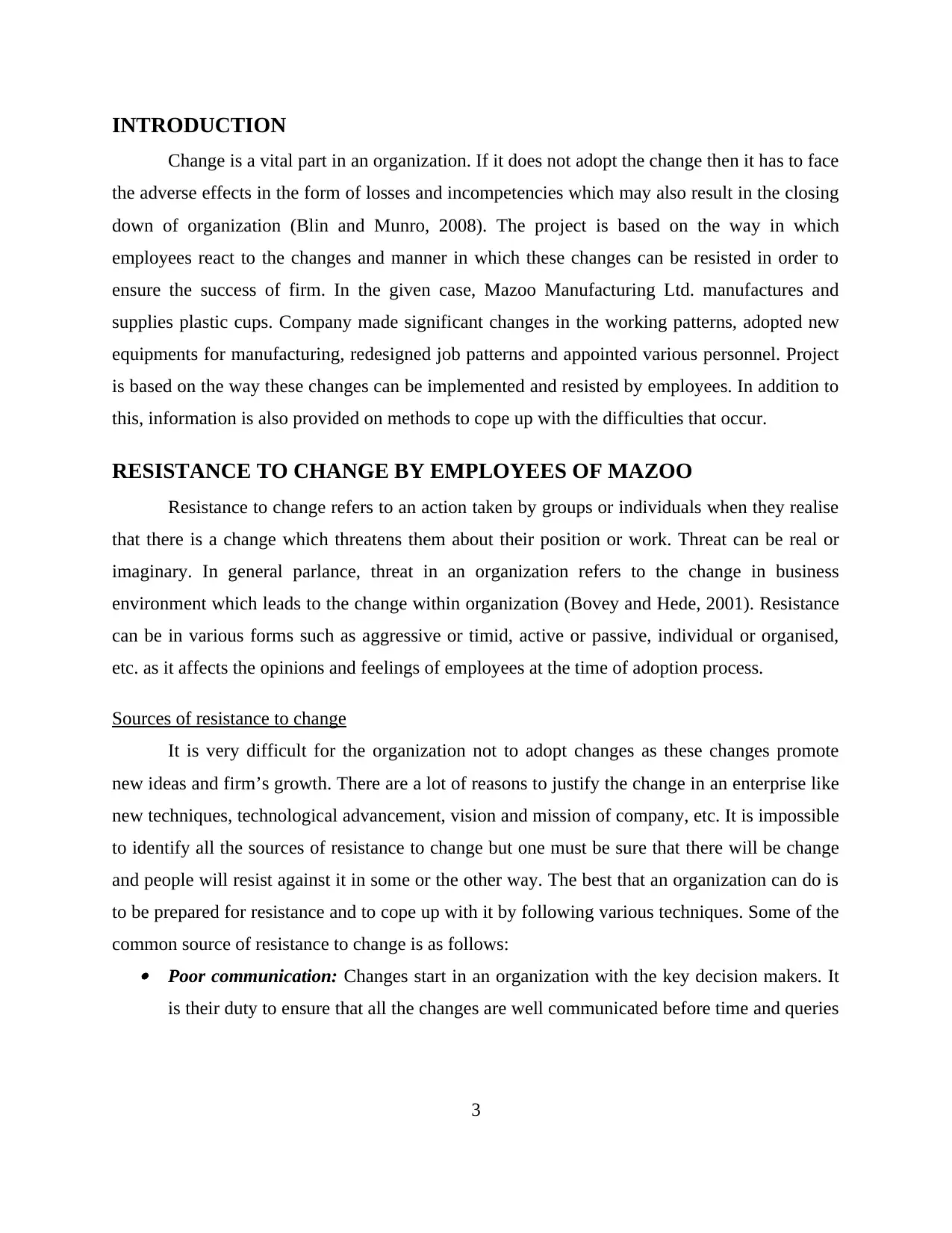
INTRODUCTION
Change is a vital part in an organization. If it does not adopt the change then it has to face
the adverse effects in the form of losses and incompetencies which may also result in the closing
down of organization (Blin and Munro, 2008). The project is based on the way in which
employees react to the changes and manner in which these changes can be resisted in order to
ensure the success of firm. In the given case, Mazoo Manufacturing Ltd. manufactures and
supplies plastic cups. Company made significant changes in the working patterns, adopted new
equipments for manufacturing, redesigned job patterns and appointed various personnel. Project
is based on the way these changes can be implemented and resisted by employees. In addition to
this, information is also provided on methods to cope up with the difficulties that occur.
RESISTANCE TO CHANGE BY EMPLOYEES OF MAZOO
Resistance to change refers to an action taken by groups or individuals when they realise
that there is a change which threatens them about their position or work. Threat can be real or
imaginary. In general parlance, threat in an organization refers to the change in business
environment which leads to the change within organization (Bovey and Hede, 2001). Resistance
can be in various forms such as aggressive or timid, active or passive, individual or organised,
etc. as it affects the opinions and feelings of employees at the time of adoption process.
Sources of resistance to change
It is very difficult for the organization not to adopt changes as these changes promote
new ideas and firm’s growth. There are a lot of reasons to justify the change in an enterprise like
new techniques, technological advancement, vision and mission of company, etc. It is impossible
to identify all the sources of resistance to change but one must be sure that there will be change
and people will resist against it in some or the other way. The best that an organization can do is
to be prepared for resistance and to cope up with it by following various techniques. Some of the
common source of resistance to change is as follows: Poor communication: Changes start in an organization with the key decision makers. It
is their duty to ensure that all the changes are well communicated before time and queries
3
Change is a vital part in an organization. If it does not adopt the change then it has to face
the adverse effects in the form of losses and incompetencies which may also result in the closing
down of organization (Blin and Munro, 2008). The project is based on the way in which
employees react to the changes and manner in which these changes can be resisted in order to
ensure the success of firm. In the given case, Mazoo Manufacturing Ltd. manufactures and
supplies plastic cups. Company made significant changes in the working patterns, adopted new
equipments for manufacturing, redesigned job patterns and appointed various personnel. Project
is based on the way these changes can be implemented and resisted by employees. In addition to
this, information is also provided on methods to cope up with the difficulties that occur.
RESISTANCE TO CHANGE BY EMPLOYEES OF MAZOO
Resistance to change refers to an action taken by groups or individuals when they realise
that there is a change which threatens them about their position or work. Threat can be real or
imaginary. In general parlance, threat in an organization refers to the change in business
environment which leads to the change within organization (Bovey and Hede, 2001). Resistance
can be in various forms such as aggressive or timid, active or passive, individual or organised,
etc. as it affects the opinions and feelings of employees at the time of adoption process.
Sources of resistance to change
It is very difficult for the organization not to adopt changes as these changes promote
new ideas and firm’s growth. There are a lot of reasons to justify the change in an enterprise like
new techniques, technological advancement, vision and mission of company, etc. It is impossible
to identify all the sources of resistance to change but one must be sure that there will be change
and people will resist against it in some or the other way. The best that an organization can do is
to be prepared for resistance and to cope up with it by following various techniques. Some of the
common source of resistance to change is as follows: Poor communication: Changes start in an organization with the key decision makers. It
is their duty to ensure that all the changes are well communicated before time and queries
3
⊘ This is a preview!⊘
Do you want full access?
Subscribe today to unlock all pages.

Trusted by 1+ million students worldwide
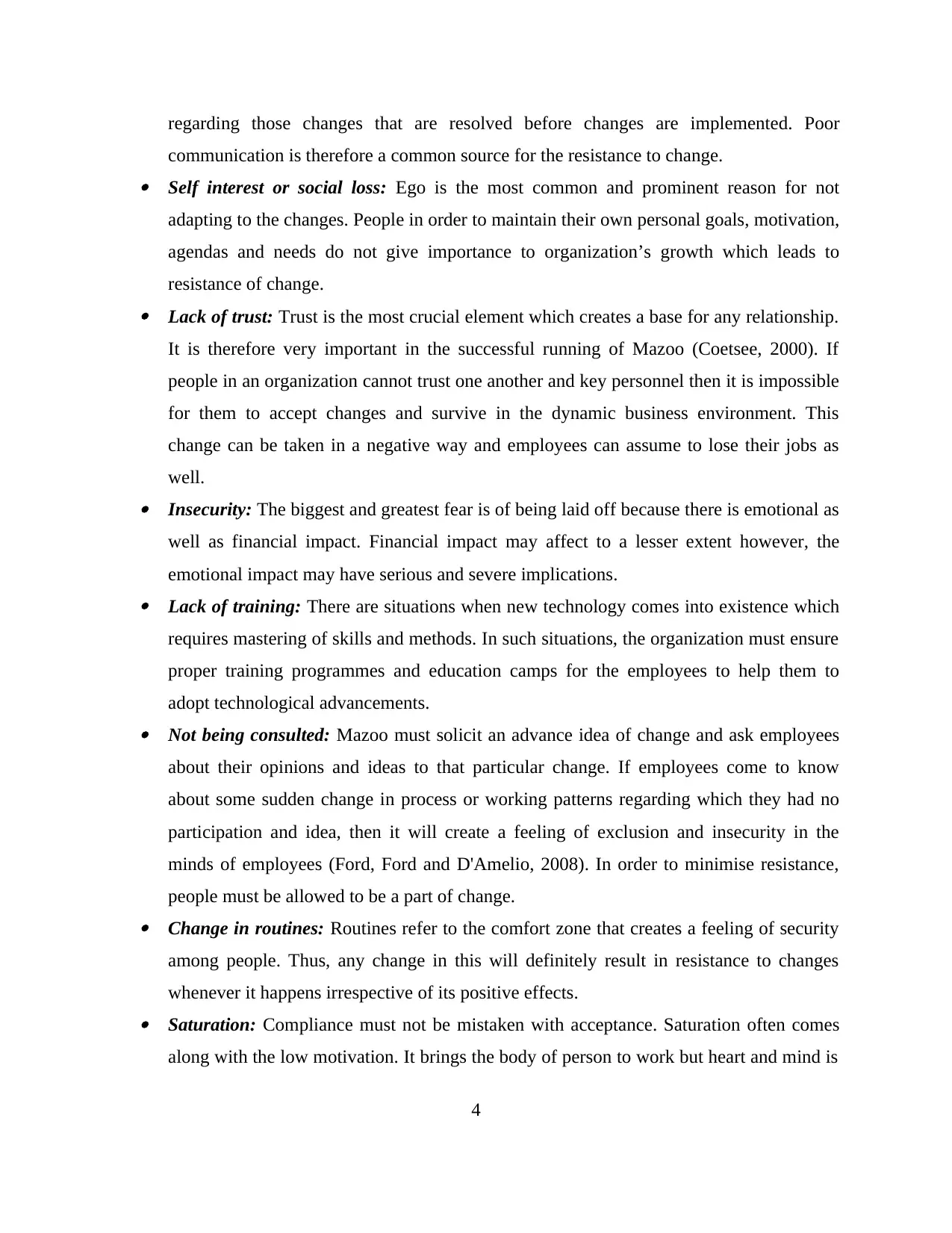
regarding those changes that are resolved before changes are implemented. Poor
communication is therefore a common source for the resistance to change. Self interest or social loss: Ego is the most common and prominent reason for not
adapting to the changes. People in order to maintain their own personal goals, motivation,
agendas and needs do not give importance to organization’s growth which leads to
resistance of change. Lack of trust: Trust is the most crucial element which creates a base for any relationship.
It is therefore very important in the successful running of Mazoo (Coetsee, 2000). If
people in an organization cannot trust one another and key personnel then it is impossible
for them to accept changes and survive in the dynamic business environment. This
change can be taken in a negative way and employees can assume to lose their jobs as
well. Insecurity: The biggest and greatest fear is of being laid off because there is emotional as
well as financial impact. Financial impact may affect to a lesser extent however, the
emotional impact may have serious and severe implications. Lack of training: There are situations when new technology comes into existence which
requires mastering of skills and methods. In such situations, the organization must ensure
proper training programmes and education camps for the employees to help them to
adopt technological advancements. Not being consulted: Mazoo must solicit an advance idea of change and ask employees
about their opinions and ideas to that particular change. If employees come to know
about some sudden change in process or working patterns regarding which they had no
participation and idea, then it will create a feeling of exclusion and insecurity in the
minds of employees (Ford, Ford and D'Amelio, 2008). In order to minimise resistance,
people must be allowed to be a part of change. Change in routines: Routines refer to the comfort zone that creates a feeling of security
among people. Thus, any change in this will definitely result in resistance to changes
whenever it happens irrespective of its positive effects. Saturation: Compliance must not be mistaken with acceptance. Saturation often comes
along with the low motivation. It brings the body of person to work but heart and mind is
4
communication is therefore a common source for the resistance to change. Self interest or social loss: Ego is the most common and prominent reason for not
adapting to the changes. People in order to maintain their own personal goals, motivation,
agendas and needs do not give importance to organization’s growth which leads to
resistance of change. Lack of trust: Trust is the most crucial element which creates a base for any relationship.
It is therefore very important in the successful running of Mazoo (Coetsee, 2000). If
people in an organization cannot trust one another and key personnel then it is impossible
for them to accept changes and survive in the dynamic business environment. This
change can be taken in a negative way and employees can assume to lose their jobs as
well. Insecurity: The biggest and greatest fear is of being laid off because there is emotional as
well as financial impact. Financial impact may affect to a lesser extent however, the
emotional impact may have serious and severe implications. Lack of training: There are situations when new technology comes into existence which
requires mastering of skills and methods. In such situations, the organization must ensure
proper training programmes and education camps for the employees to help them to
adopt technological advancements. Not being consulted: Mazoo must solicit an advance idea of change and ask employees
about their opinions and ideas to that particular change. If employees come to know
about some sudden change in process or working patterns regarding which they had no
participation and idea, then it will create a feeling of exclusion and insecurity in the
minds of employees (Ford, Ford and D'Amelio, 2008). In order to minimise resistance,
people must be allowed to be a part of change. Change in routines: Routines refer to the comfort zone that creates a feeling of security
among people. Thus, any change in this will definitely result in resistance to changes
whenever it happens irrespective of its positive effects. Saturation: Compliance must not be mistaken with acceptance. Saturation often comes
along with the low motivation. It brings the body of person to work but heart and mind is
4
Paraphrase This Document
Need a fresh take? Get an instant paraphrase of this document with our AI Paraphraser
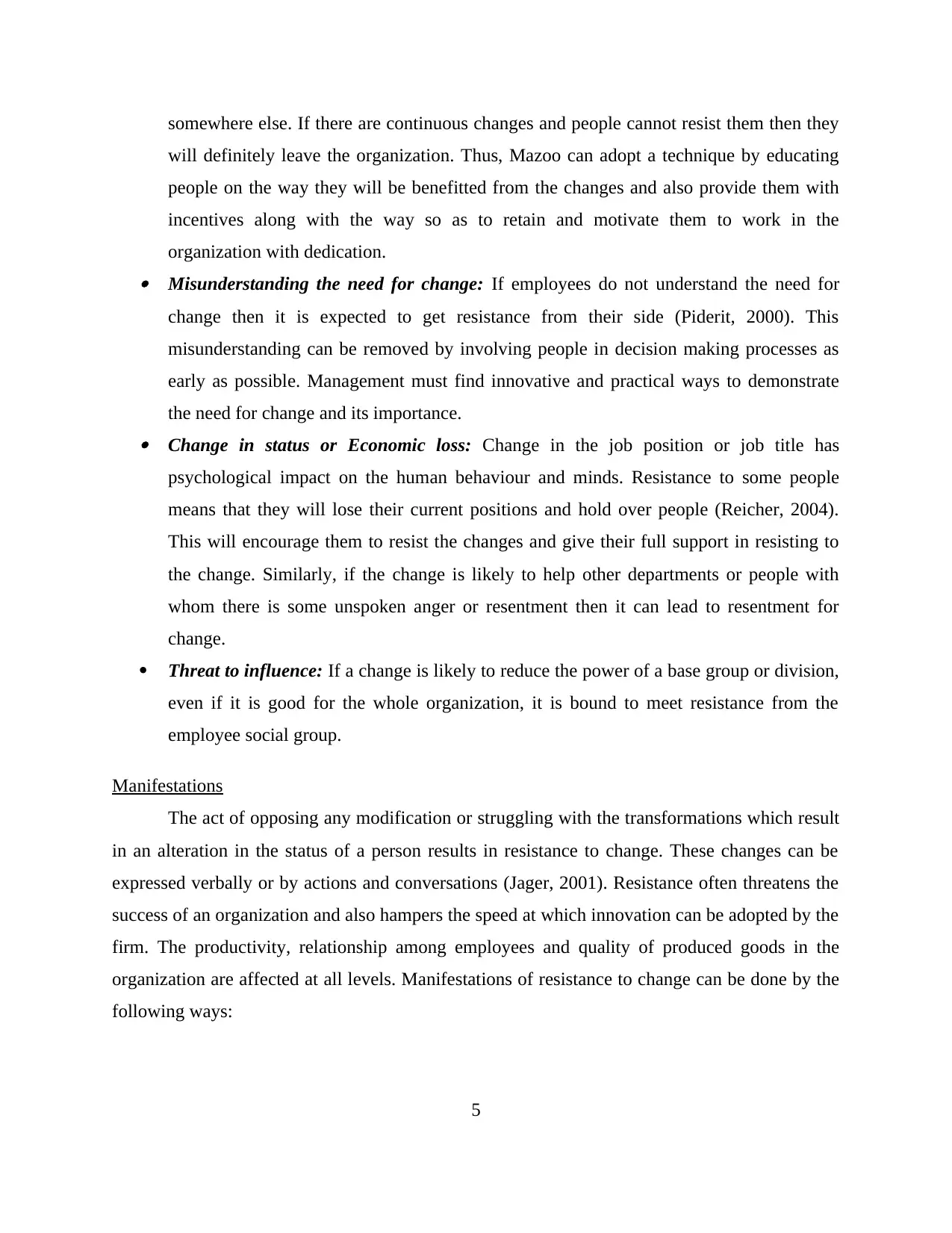
somewhere else. If there are continuous changes and people cannot resist them then they
will definitely leave the organization. Thus, Mazoo can adopt a technique by educating
people on the way they will be benefitted from the changes and also provide them with
incentives along with the way so as to retain and motivate them to work in the
organization with dedication. Misunderstanding the need for change: If employees do not understand the need for
change then it is expected to get resistance from their side (Piderit, 2000). This
misunderstanding can be removed by involving people in decision making processes as
early as possible. Management must find innovative and practical ways to demonstrate
the need for change and its importance. Change in status or Economic loss: Change in the job position or job title has
psychological impact on the human behaviour and minds. Resistance to some people
means that they will lose their current positions and hold over people (Reicher, 2004).
This will encourage them to resist the changes and give their full support in resisting to
the change. Similarly, if the change is likely to help other departments or people with
whom there is some unspoken anger or resentment then it can lead to resentment for
change.
Threat to influence: If a change is likely to reduce the power of a base group or division,
even if it is good for the whole organization, it is bound to meet resistance from the
employee social group.
Manifestations
The act of opposing any modification or struggling with the transformations which result
in an alteration in the status of a person results in resistance to change. These changes can be
expressed verbally or by actions and conversations (Jager, 2001). Resistance often threatens the
success of an organization and also hampers the speed at which innovation can be adopted by the
firm. The productivity, relationship among employees and quality of produced goods in the
organization are affected at all levels. Manifestations of resistance to change can be done by the
following ways:
5
will definitely leave the organization. Thus, Mazoo can adopt a technique by educating
people on the way they will be benefitted from the changes and also provide them with
incentives along with the way so as to retain and motivate them to work in the
organization with dedication. Misunderstanding the need for change: If employees do not understand the need for
change then it is expected to get resistance from their side (Piderit, 2000). This
misunderstanding can be removed by involving people in decision making processes as
early as possible. Management must find innovative and practical ways to demonstrate
the need for change and its importance. Change in status or Economic loss: Change in the job position or job title has
psychological impact on the human behaviour and minds. Resistance to some people
means that they will lose their current positions and hold over people (Reicher, 2004).
This will encourage them to resist the changes and give their full support in resisting to
the change. Similarly, if the change is likely to help other departments or people with
whom there is some unspoken anger or resentment then it can lead to resentment for
change.
Threat to influence: If a change is likely to reduce the power of a base group or division,
even if it is good for the whole organization, it is bound to meet resistance from the
employee social group.
Manifestations
The act of opposing any modification or struggling with the transformations which result
in an alteration in the status of a person results in resistance to change. These changes can be
expressed verbally or by actions and conversations (Jager, 2001). Resistance often threatens the
success of an organization and also hampers the speed at which innovation can be adopted by the
firm. The productivity, relationship among employees and quality of produced goods in the
organization are affected at all levels. Manifestations of resistance to change can be done by the
following ways:
5
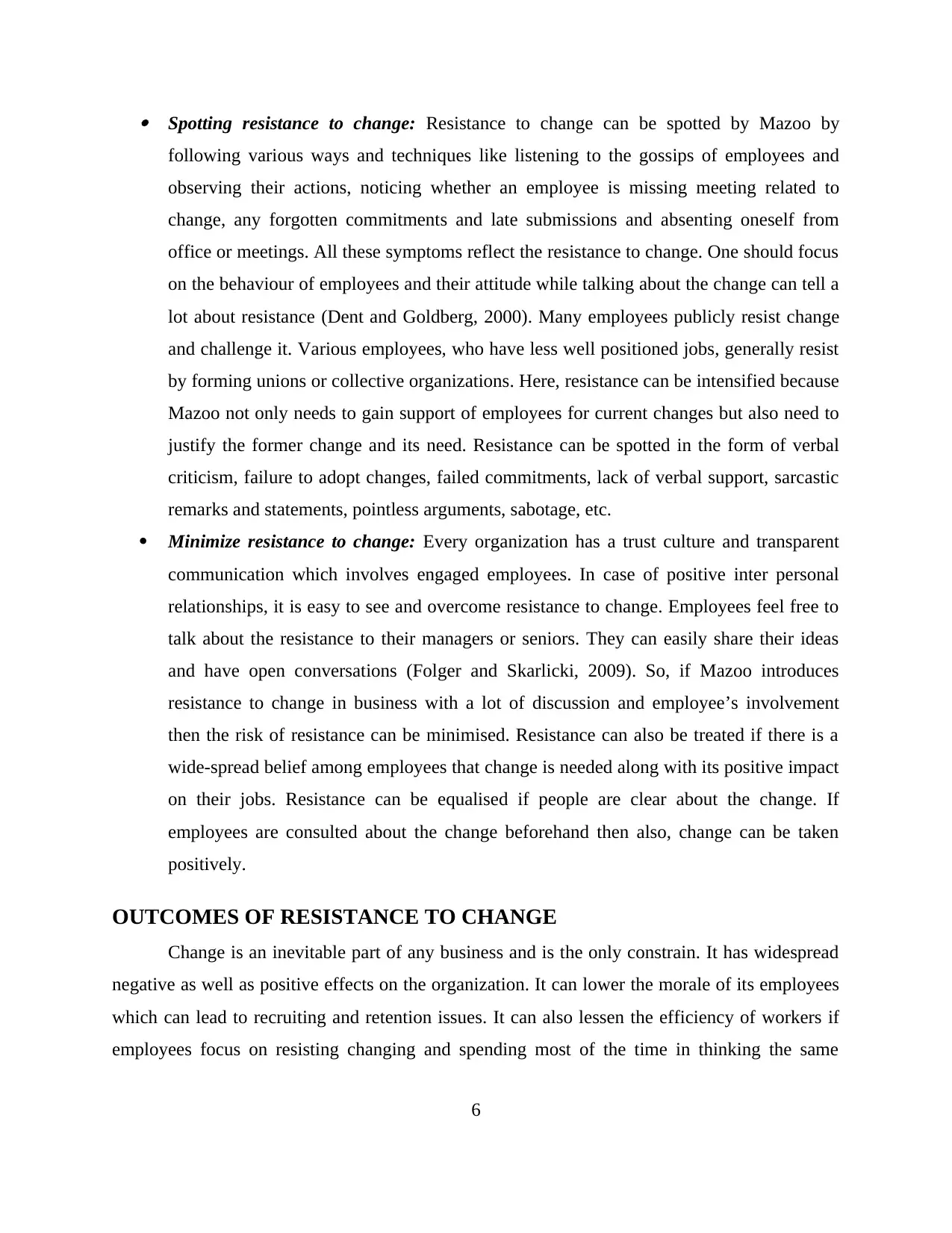
Spotting resistance to change: Resistance to change can be spotted by Mazoo by
following various ways and techniques like listening to the gossips of employees and
observing their actions, noticing whether an employee is missing meeting related to
change, any forgotten commitments and late submissions and absenting oneself from
office or meetings. All these symptoms reflect the resistance to change. One should focus
on the behaviour of employees and their attitude while talking about the change can tell a
lot about resistance (Dent and Goldberg, 2000). Many employees publicly resist change
and challenge it. Various employees, who have less well positioned jobs, generally resist
by forming unions or collective organizations. Here, resistance can be intensified because
Mazoo not only needs to gain support of employees for current changes but also need to
justify the former change and its need. Resistance can be spotted in the form of verbal
criticism, failure to adopt changes, failed commitments, lack of verbal support, sarcastic
remarks and statements, pointless arguments, sabotage, etc.
Minimize resistance to change: Every organization has a trust culture and transparent
communication which involves engaged employees. In case of positive inter personal
relationships, it is easy to see and overcome resistance to change. Employees feel free to
talk about the resistance to their managers or seniors. They can easily share their ideas
and have open conversations (Folger and Skarlicki, 2009). So, if Mazoo introduces
resistance to change in business with a lot of discussion and employee’s involvement
then the risk of resistance can be minimised. Resistance can also be treated if there is a
wide-spread belief among employees that change is needed along with its positive impact
on their jobs. Resistance can be equalised if people are clear about the change. If
employees are consulted about the change beforehand then also, change can be taken
positively.
OUTCOMES OF RESISTANCE TO CHANGE
Change is an inevitable part of any business and is the only constrain. It has widespread
negative as well as positive effects on the organization. It can lower the morale of its employees
which can lead to recruiting and retention issues. It can also lessen the efficiency of workers if
employees focus on resisting changing and spending most of the time in thinking the same
6
following various ways and techniques like listening to the gossips of employees and
observing their actions, noticing whether an employee is missing meeting related to
change, any forgotten commitments and late submissions and absenting oneself from
office or meetings. All these symptoms reflect the resistance to change. One should focus
on the behaviour of employees and their attitude while talking about the change can tell a
lot about resistance (Dent and Goldberg, 2000). Many employees publicly resist change
and challenge it. Various employees, who have less well positioned jobs, generally resist
by forming unions or collective organizations. Here, resistance can be intensified because
Mazoo not only needs to gain support of employees for current changes but also need to
justify the former change and its need. Resistance can be spotted in the form of verbal
criticism, failure to adopt changes, failed commitments, lack of verbal support, sarcastic
remarks and statements, pointless arguments, sabotage, etc.
Minimize resistance to change: Every organization has a trust culture and transparent
communication which involves engaged employees. In case of positive inter personal
relationships, it is easy to see and overcome resistance to change. Employees feel free to
talk about the resistance to their managers or seniors. They can easily share their ideas
and have open conversations (Folger and Skarlicki, 2009). So, if Mazoo introduces
resistance to change in business with a lot of discussion and employee’s involvement
then the risk of resistance can be minimised. Resistance can also be treated if there is a
wide-spread belief among employees that change is needed along with its positive impact
on their jobs. Resistance can be equalised if people are clear about the change. If
employees are consulted about the change beforehand then also, change can be taken
positively.
OUTCOMES OF RESISTANCE TO CHANGE
Change is an inevitable part of any business and is the only constrain. It has widespread
negative as well as positive effects on the organization. It can lower the morale of its employees
which can lead to recruiting and retention issues. It can also lessen the efficiency of workers if
employees focus on resisting changing and spending most of the time in thinking the same
6
⊘ This is a preview!⊘
Do you want full access?
Subscribe today to unlock all pages.

Trusted by 1+ million students worldwide
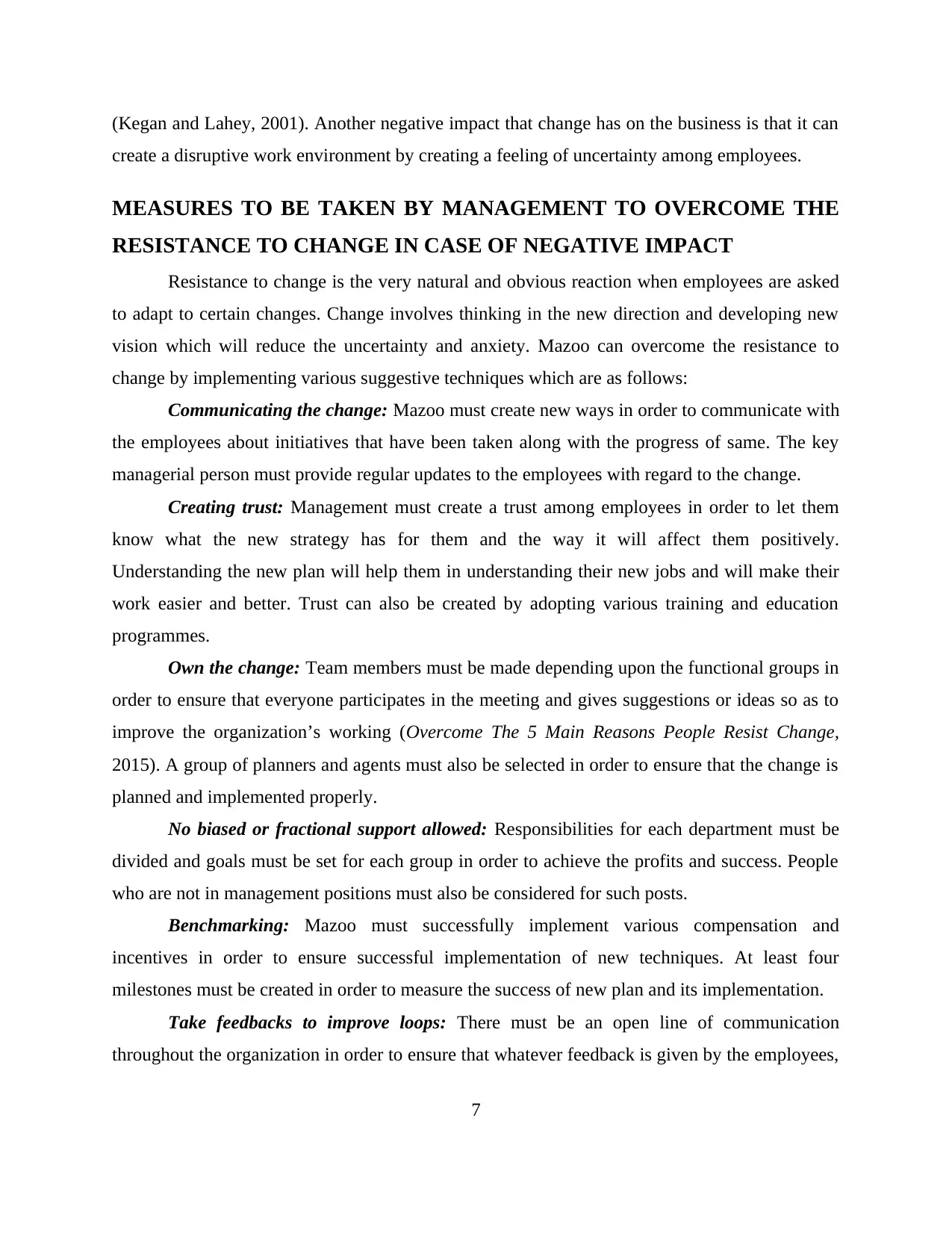
(Kegan and Lahey, 2001). Another negative impact that change has on the business is that it can
create a disruptive work environment by creating a feeling of uncertainty among employees.
MEASURES TO BE TAKEN BY MANAGEMENT TO OVERCOME THE
RESISTANCE TO CHANGE IN CASE OF NEGATIVE IMPACT
Resistance to change is the very natural and obvious reaction when employees are asked
to adapt to certain changes. Change involves thinking in the new direction and developing new
vision which will reduce the uncertainty and anxiety. Mazoo can overcome the resistance to
change by implementing various suggestive techniques which are as follows:
Communicating the change: Mazoo must create new ways in order to communicate with
the employees about initiatives that have been taken along with the progress of same. The key
managerial person must provide regular updates to the employees with regard to the change.
Creating trust: Management must create a trust among employees in order to let them
know what the new strategy has for them and the way it will affect them positively.
Understanding the new plan will help them in understanding their new jobs and will make their
work easier and better. Trust can also be created by adopting various training and education
programmes.
Own the change: Team members must be made depending upon the functional groups in
order to ensure that everyone participates in the meeting and gives suggestions or ideas so as to
improve the organization’s working (Overcome The 5 Main Reasons People Resist Change,
2015). A group of planners and agents must also be selected in order to ensure that the change is
planned and implemented properly.
No biased or fractional support allowed: Responsibilities for each department must be
divided and goals must be set for each group in order to achieve the profits and success. People
who are not in management positions must also be considered for such posts.
Benchmarking: Mazoo must successfully implement various compensation and
incentives in order to ensure successful implementation of new techniques. At least four
milestones must be created in order to measure the success of new plan and its implementation.
Take feedbacks to improve loops: There must be an open line of communication
throughout the organization in order to ensure that whatever feedback is given by the employees,
7
create a disruptive work environment by creating a feeling of uncertainty among employees.
MEASURES TO BE TAKEN BY MANAGEMENT TO OVERCOME THE
RESISTANCE TO CHANGE IN CASE OF NEGATIVE IMPACT
Resistance to change is the very natural and obvious reaction when employees are asked
to adapt to certain changes. Change involves thinking in the new direction and developing new
vision which will reduce the uncertainty and anxiety. Mazoo can overcome the resistance to
change by implementing various suggestive techniques which are as follows:
Communicating the change: Mazoo must create new ways in order to communicate with
the employees about initiatives that have been taken along with the progress of same. The key
managerial person must provide regular updates to the employees with regard to the change.
Creating trust: Management must create a trust among employees in order to let them
know what the new strategy has for them and the way it will affect them positively.
Understanding the new plan will help them in understanding their new jobs and will make their
work easier and better. Trust can also be created by adopting various training and education
programmes.
Own the change: Team members must be made depending upon the functional groups in
order to ensure that everyone participates in the meeting and gives suggestions or ideas so as to
improve the organization’s working (Overcome The 5 Main Reasons People Resist Change,
2015). A group of planners and agents must also be selected in order to ensure that the change is
planned and implemented properly.
No biased or fractional support allowed: Responsibilities for each department must be
divided and goals must be set for each group in order to achieve the profits and success. People
who are not in management positions must also be considered for such posts.
Benchmarking: Mazoo must successfully implement various compensation and
incentives in order to ensure successful implementation of new techniques. At least four
milestones must be created in order to measure the success of new plan and its implementation.
Take feedbacks to improve loops: There must be an open line of communication
throughout the organization in order to ensure that whatever feedback is given by the employees,
7
Paraphrase This Document
Need a fresh take? Get an instant paraphrase of this document with our AI Paraphraser
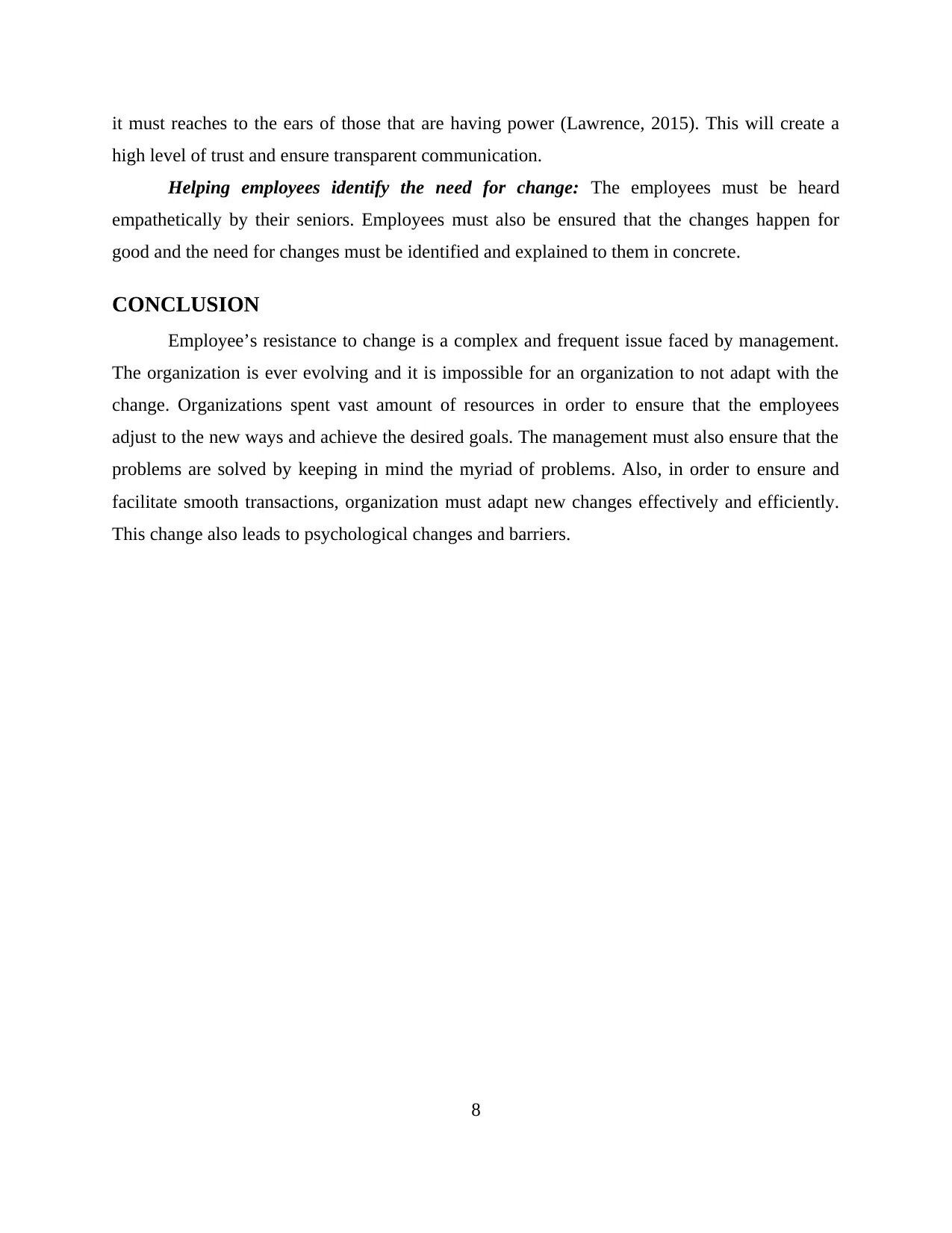
it must reaches to the ears of those that are having power (Lawrence, 2015). This will create a
high level of trust and ensure transparent communication.
Helping employees identify the need for change: The employees must be heard
empathetically by their seniors. Employees must also be ensured that the changes happen for
good and the need for changes must be identified and explained to them in concrete.
CONCLUSION
Employee’s resistance to change is a complex and frequent issue faced by management.
The organization is ever evolving and it is impossible for an organization to not adapt with the
change. Organizations spent vast amount of resources in order to ensure that the employees
adjust to the new ways and achieve the desired goals. The management must also ensure that the
problems are solved by keeping in mind the myriad of problems. Also, in order to ensure and
facilitate smooth transactions, organization must adapt new changes effectively and efficiently.
This change also leads to psychological changes and barriers.
8
high level of trust and ensure transparent communication.
Helping employees identify the need for change: The employees must be heard
empathetically by their seniors. Employees must also be ensured that the changes happen for
good and the need for changes must be identified and explained to them in concrete.
CONCLUSION
Employee’s resistance to change is a complex and frequent issue faced by management.
The organization is ever evolving and it is impossible for an organization to not adapt with the
change. Organizations spent vast amount of resources in order to ensure that the employees
adjust to the new ways and achieve the desired goals. The management must also ensure that the
problems are solved by keeping in mind the myriad of problems. Also, in order to ensure and
facilitate smooth transactions, organization must adapt new changes effectively and efficiently.
This change also leads to psychological changes and barriers.
8
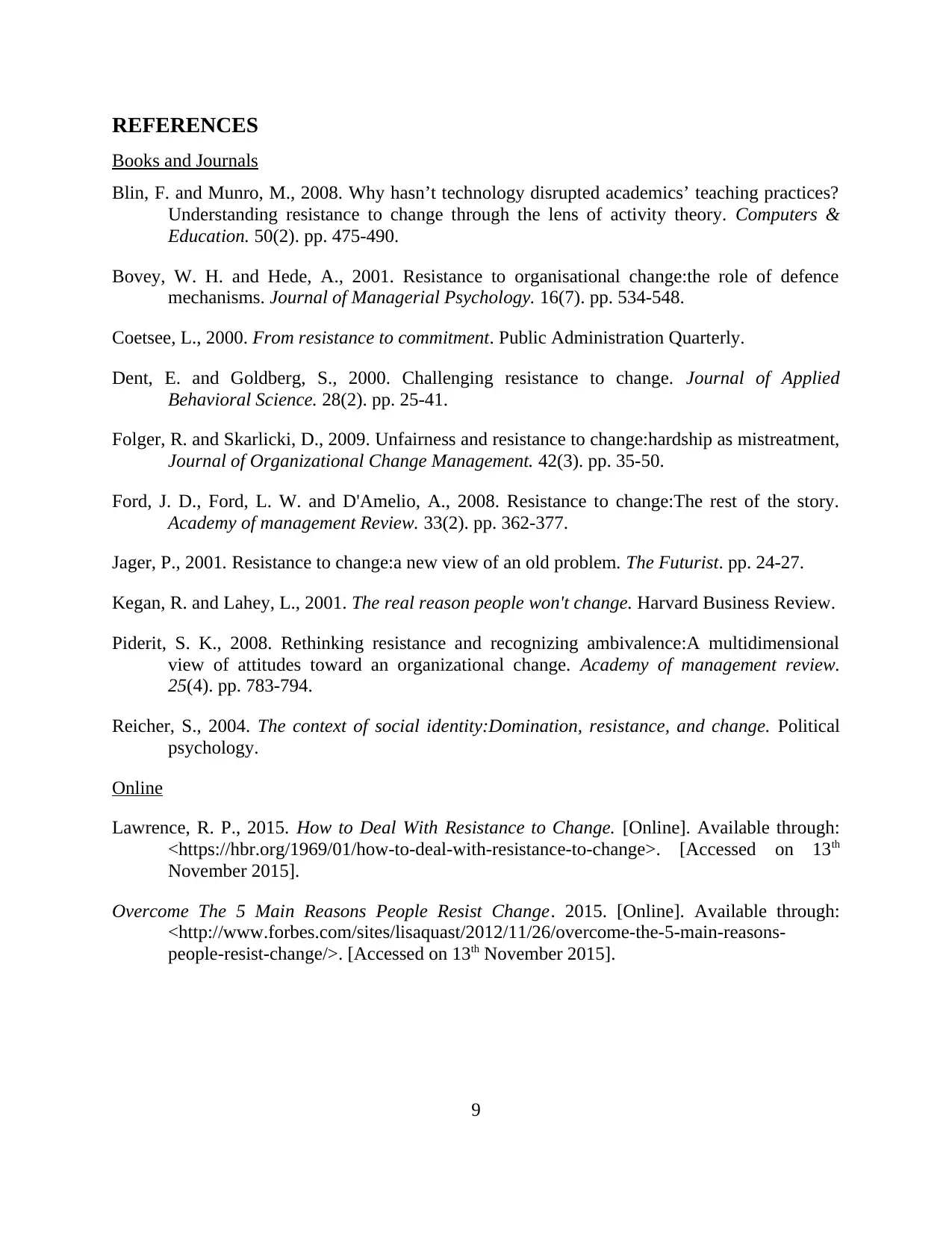
REFERENCES
Books and Journals
Blin, F. and Munro, M., 2008. Why hasn’t technology disrupted academics’ teaching practices?
Understanding resistance to change through the lens of activity theory. Computers &
Education. 50(2). pp. 475-490.
Bovey, W. H. and Hede, A., 2001. Resistance to organisational change:the role of defence
mechanisms. Journal of Managerial Psychology. 16(7). pp. 534-548.
Coetsee, L., 2000. From resistance to commitment. Public Administration Quarterly.
Dent, E. and Goldberg, S., 2000. Challenging resistance to change. Journal of Applied
Behavioral Science. 28(2). pp. 25-41.
Folger, R. and Skarlicki, D., 2009. Unfairness and resistance to change:hardship as mistreatment,
Journal of Organizational Change Management. 42(3). pp. 35-50.
Ford, J. D., Ford, L. W. and D'Amelio, A., 2008. Resistance to change:The rest of the story.
Academy of management Review. 33(2). pp. 362-377.
Jager, P., 2001. Resistance to change:a new view of an old problem. The Futurist. pp. 24-27.
Kegan, R. and Lahey, L., 2001. The real reason people won't change. Harvard Business Review.
Piderit, S. K., 2008. Rethinking resistance and recognizing ambivalence:A multidimensional
view of attitudes toward an organizational change. Academy of management review.
25(4). pp. 783-794.
Reicher, S., 2004. The context of social identity:Domination, resistance, and change. Political
psychology.
Online
Lawrence, R. P., 2015. How to Deal With Resistance to Change. [Online]. Available through:
<https://hbr.org/1969/01/how-to-deal-with-resistance-to-change>. [Accessed on 13th
November 2015].
Overcome The 5 Main Reasons People Resist Change. 2015. [Online]. Available through:
<http://www.forbes.com/sites/lisaquast/2012/11/26/overcome-the-5-main-reasons-
people-resist-change/>. [Accessed on 13th November 2015].
9
Books and Journals
Blin, F. and Munro, M., 2008. Why hasn’t technology disrupted academics’ teaching practices?
Understanding resistance to change through the lens of activity theory. Computers &
Education. 50(2). pp. 475-490.
Bovey, W. H. and Hede, A., 2001. Resistance to organisational change:the role of defence
mechanisms. Journal of Managerial Psychology. 16(7). pp. 534-548.
Coetsee, L., 2000. From resistance to commitment. Public Administration Quarterly.
Dent, E. and Goldberg, S., 2000. Challenging resistance to change. Journal of Applied
Behavioral Science. 28(2). pp. 25-41.
Folger, R. and Skarlicki, D., 2009. Unfairness and resistance to change:hardship as mistreatment,
Journal of Organizational Change Management. 42(3). pp. 35-50.
Ford, J. D., Ford, L. W. and D'Amelio, A., 2008. Resistance to change:The rest of the story.
Academy of management Review. 33(2). pp. 362-377.
Jager, P., 2001. Resistance to change:a new view of an old problem. The Futurist. pp. 24-27.
Kegan, R. and Lahey, L., 2001. The real reason people won't change. Harvard Business Review.
Piderit, S. K., 2008. Rethinking resistance and recognizing ambivalence:A multidimensional
view of attitudes toward an organizational change. Academy of management review.
25(4). pp. 783-794.
Reicher, S., 2004. The context of social identity:Domination, resistance, and change. Political
psychology.
Online
Lawrence, R. P., 2015. How to Deal With Resistance to Change. [Online]. Available through:
<https://hbr.org/1969/01/how-to-deal-with-resistance-to-change>. [Accessed on 13th
November 2015].
Overcome The 5 Main Reasons People Resist Change. 2015. [Online]. Available through:
<http://www.forbes.com/sites/lisaquast/2012/11/26/overcome-the-5-main-reasons-
people-resist-change/>. [Accessed on 13th November 2015].
9
⊘ This is a preview!⊘
Do you want full access?
Subscribe today to unlock all pages.

Trusted by 1+ million students worldwide
1 out of 9
Related Documents
Your All-in-One AI-Powered Toolkit for Academic Success.
+13062052269
info@desklib.com
Available 24*7 on WhatsApp / Email
![[object Object]](/_next/static/media/star-bottom.7253800d.svg)
Unlock your academic potential
Copyright © 2020–2025 A2Z Services. All Rights Reserved. Developed and managed by ZUCOL.





